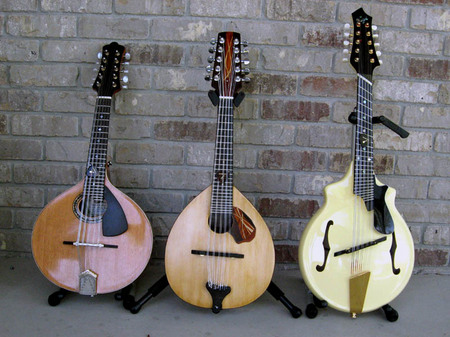« 10-string review; Gypsy's Music nylon strung mandolin |
Main
| Breathtaking treasures at The Acoustic Music Company »
 April 30, 2010 | Thirty! April 30, 2010 | Thirty!
The theme for this week in the JazzMando Research Lab has been "10-string." A rare opportunity for extended hands-on comparison, we've been able to take a close look at three different approaches to 10-string design at once. (Rough job, but somebody's got to do it...) The first two regular mandolin scale, a JP Charles archtop bandolim, with more of the characteristic Brazilian brilliance (tempered by our use of D'addario Chrome Flatwound strings), the second was the recently reviewed Gypsy's Music nylon string with its warmer, richly round tonal character.

Click for close-up
The third is one we hope to give a detailed report on soon. Fresh off the bench of New England Luthier Pete Langdell of Rigel Instruments, this R-200 start its life off as an 8-string mandola, and with a new neck, bridge, tailpiece, tuners, K&K pickup, and the revolutionary fanned fret system, the instrument is now a 10-string. We're asked frequently about the adjustment in playing this system, but really, it only takes a few minutes to adjust. Since you have mandolin scale (14-1/2") on the E-strings and mandola scale (16") on the C-strings with a the inside strings graduated between, it isn't any different than the natural adjustment one might make playing the two different instruments in one setting. If you want access to the best in both ranges, you have to make the acclimation one way or the other.
The voicings offered by the extended range of a 5-course instrument are a joy to experiment with. We lean toward 3- and 4-voice chords, and being able to more easily fill out a two-octave scale over more fretboard real estate means more opportunity for chord melody and solo playing.
Thirty! That's a lot of strings!
Posted by Ted at April 30, 2010 5:57 AM

Disclaimer: In the 'Information Age' of the 21st Century,
any fool with a computer, a modem, and an idea can
become a self-professed 'expert." This site does not
come equipped with 'discernment.'
|



